Drying Clothes: Best Practices and Fabric Care
Proper drying techniques are essential for maintaining the quality and longevity of your clothes. Different fabrics require specific drying methods to prevent shrinkage, fading, or damage. Whether using a dryer, air drying, or specialized techniques for delicate garments, choosing the right approach helps preserve fabric integrity. By following best practices, you can keep your clothes looking fresh and in great condition for longer.
1. Why proper drying matters
Properly drying clothes is just as crucial as washing them correctly. It’s not simply about getting items dry; it’s about preserving the quality, shape, and lifespan of your garments. Think of it as the final, essential step in clothing care. Neglecting this stage can lead to irreversible damage, increased energy consumption, and even a negative impact on the environment.
1.1 Protecting your clothes: Preventing shrinkage, fading, and damage
Improper drying techniques are a primary cause of clothing damage. One of the most common issues is shrinkage. Certain materials, especially natural fibers, are highly susceptible to shrinking when exposed to excessive heat or harsh agitation in a dryer. Over-drying, where clothes are left in the dryer for too long, can make fabrics brittle and prone to tearing.
Excessive heat can also cause colors to fade, making your vibrant clothes look dull and worn out. Improper drying techniques, such as hanging darks in direct sunlight, can worsen the issue.
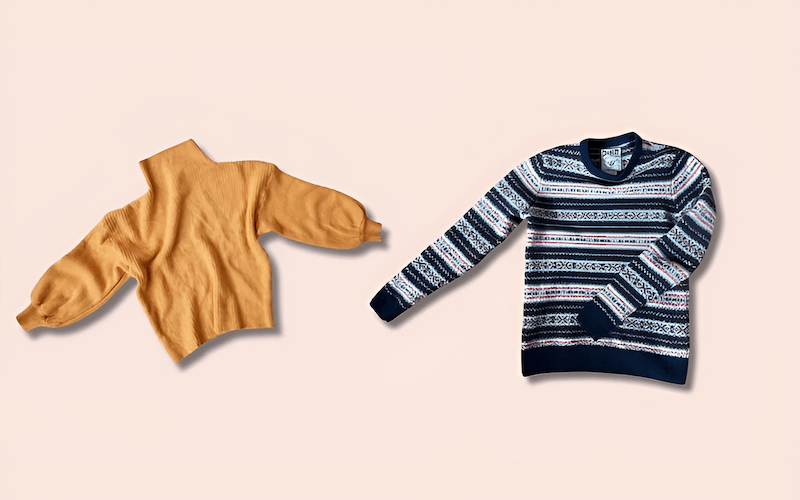
1.2 Saving time and energy: Efficient drying techniques
Efficient drying isn’t just about speed; it’s about optimizing the process to save both time and energy. Utilizing proper drying techniques significantly reduces drying time.
For instance, air drying, when done correctly, can be surprisingly efficient, especially in favorable ambient temperatures and with good airflow pressure. This method eliminates the energy consumption of a dryer altogether. Even when using a machine dryer, understanding the appropriate settings and avoiding overloading can drastically reduce energy usage and the time your clothes spend tumbling.
1.3 The environmental impact of drying clothes
The environmental impact of our laundry habits is often overlooked. Dryers are energy-intensive appliances. Choosing more sustainable drying methods, like air drying, significantly reduces your carbon footprint. When drying outdoors, it will be useful to know the weather conditions. UV Index or Pollen Count need to be considered.
Choosing to air dry, even occasionally, can make a difference in reducing overall energy consumption and promoting a more sustainable lifestyle.
2. Understanding your fabrics
Different fabrics have unique characteristics that dictate their drying needs. Understanding these needs is essential for preserving the quality and longevity of garments. Reading care labels helps grasp the characteristics of fabric.
2.1 Reading care labels: Decoding the symbols
Table: Common drying symbols and their meanings
| Symbol | Meaning |
|---|---|
| Circle in a square | Tumble dry |
| Circle in a square with a dot | Tumble dry low heat |
| Circle in a square with two dots | Tumble dry medium heat |
| Circle in a square with three dots | Tumble dry high heat |
| Circle in a square with an X | Do not tumble dry |
| Square with a horizontal line | Dry flat |
| Square with three vertical lines | Drip dry |
| Square with a curved line in the top left corner | Hang to dry |
| Square with a diagonal line in the top left corner | Dry in the shade |
Care labels are your best friend when it comes to laundry. These small tags provide valuable instructions, including the recommended drying method, directly from the manufacturer. Ignoring these instructions can lead to irreversible damage. The symbols on the label are standardized, so they provide information quickly.
2.2 Common fabrics and their drying needs
Different fabrics require different drying methods.
Cotton
Cotton is a durable and commonly used fabric, but it has a medium shrinkage risk. While it can be tumble dried on low heat, air drying is often recommended to minimize shrinkage and preserve the fabric’s integrity.

Linen
Linen is known for its breathability and strength, but it’s also highly prone to wrinkling. The best way to dry linen is to air dry it, either by hanging it or laying it flat. This helps to minimize wrinkles and maintain the fabric’s crispness.
Silk
Silk is a luxurious and delicate fabric with a high risk of shrinking. Harsh drying methods can easily damage it. The safest way to dry silk is to lay it flat on a clean, dry surface, away from direct sunlight or heat. Avoid wringing or twisting the garment.
Wool
Wool is another fabric that’s highly susceptible to shrinkage and can easily be damaged. Heat and agitation can cause the fibers to felt and shrink. The best way to dry wool is to lay it flat on a clean, dry surface, reshaping the garment as needed.
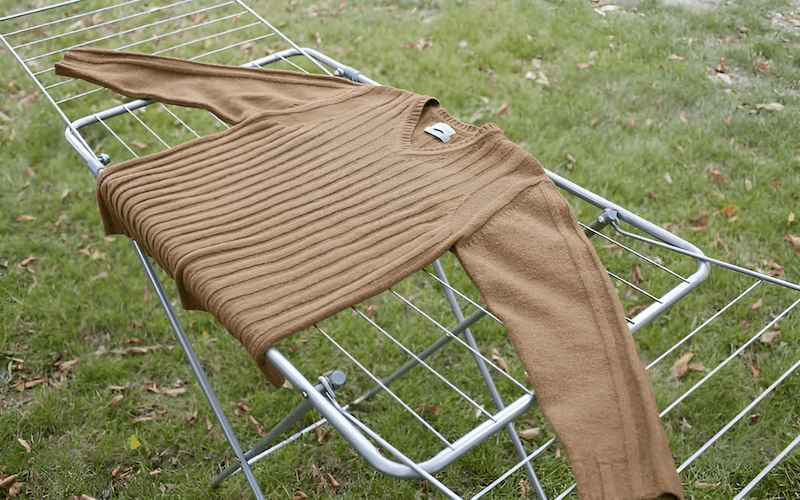
Synthetics (Polyester, Nylon, Spandex, etc.)
Synthetic fabrics like polyester, nylon, and spandex are generally more resilient than natural fibers. They have low shrinkage risk and can often be tumble dried on low heat. However, air drying is still a good option to preserve the elasticity of fabrics like spandex.
Delicates (Lace, Lingerie)
Delicates, such as lace and lingerie, require extra gentle care. They should never be put in the dryer, as the heat and agitation can damage the delicate fibers, underwire, and embellishments. Hand washing and laying flat to dry is the best approach.
Jeans/Denim
Jeans, made from denim, are relatively durable, but they can fade over time. To minimize fading, it’s best to hang dry them inside out. This protects the outer surface from direct sunlight or the harshness of the dryer.
Activewear
Activewear often contains elastic fibers that can be damaged by heat. Air drying is the preferred method for activewear, as it helps to preserve the elasticity and shape of the garments. Avoid hanging them in direct sunlight, which can cause fading.
3. Air drying: the gentle approach
Air drying is a gentle and energy-efficient method that’s suitable for all types of fabrics. It involves using natural air circulation, either outdoors or indoors, to remove moisture from clothes. This approach minimizes shrinkage, prevents fading, and extends the lifespan of garments.
3.1 Benefits of air drying
Air drying offers numerous benefits, making it a superior choice for many laundry situations. Sunlight is also known for its antibacterial and brightening properties. Using clothesline helps to keep your white clothes naturally bright, and extend garment life. Air-dried items also tend to have less static and fewer wrinkles compared to machine-dried clothes.
3.2 Outdoor air drying
Outdoor air drying is the traditional method, harnessing the power of the sun and wind.
Setting Up a Clothesline: Location, Materials, and Techniques
Choosing the right location for your clothesline is crucial. Select an area that receives ample sunlight and has good air circulation. Consider the wind speed to will dry effectively.
Using Clothespins Effectively
Clothespins are essential for securing clothes to the line, but they can leave marks if not used correctly. Choose clothespins that provide a secure grip without being too tight.
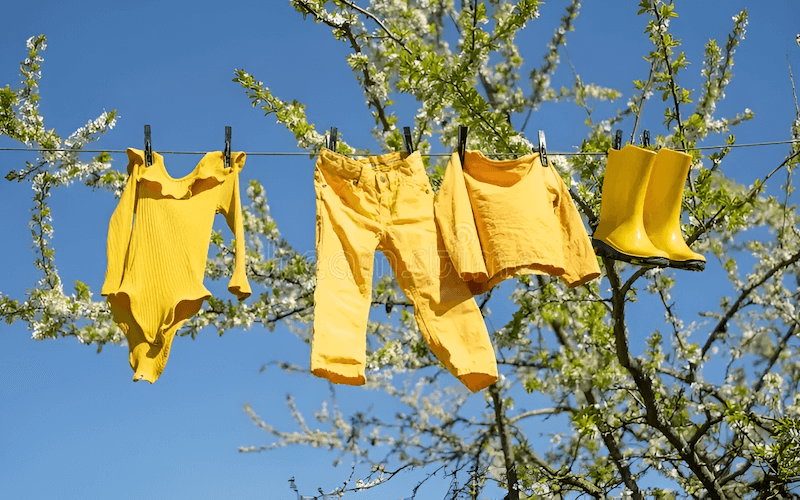
Hanging Techniques for Different Garments (Shirts, Pants, Socks, etc.)
Different garments require specific hanging techniques to maximize drying efficiency and prevent wrinkles. Shirts, pants, socks, underwear, bras, and bed linens each have an optimal hanging method. For example, hanging pants upside down by the hems helps them dry faster and minimizes wrinkles.
The Power of Sunlight: Natural Disinfection and Whitening
Sunlight has natural disinfecting and whitening properties. The UV rays help kill bacteria and can naturally bleach white fabrics, reducing the need for harsh chemical bleaches.
Weather Considerations: Sun, Wind, Rain, and Pollen
Weather conditions significantly impact outdoor air drying. While sun and wind are beneficial, rain and high humidity will hinder the process. Be mindful of pollen counts if you or anyone in your household has allergies.
3.3 Indoor air drying
Indoor air drying is a practical alternative when outdoor drying isn’t possible or convenient.
Choosing a Drying Rack: Types and Features
There are various types of drying racks available, from simple folding racks to multi-tiered models. Consider the amount of space you have and the types of garments you typically dry when selecting a rack. Look for features that promote airflow and offer space-saving designs.
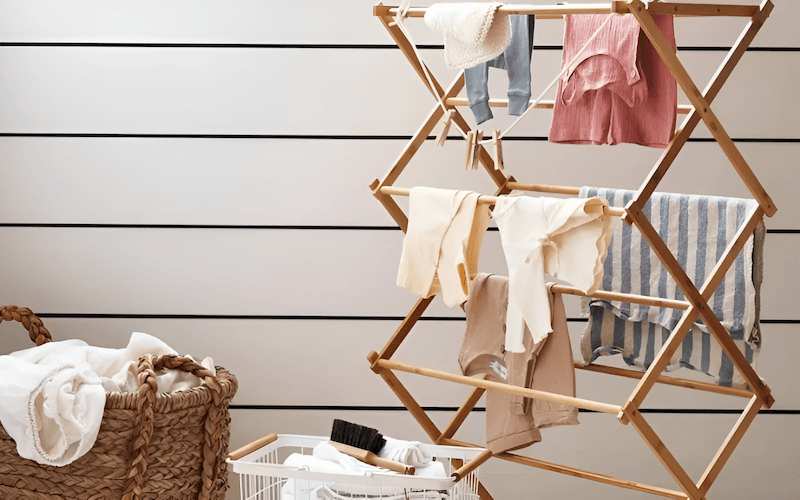
Maximizing Airflow: Placement and Ventilation
Proper ventilation is key to successful indoor air drying. Place the drying rack in a well-ventilated area, such as near a window, vent, or fan. Good air circulation will speed up the drying process and prevent musty odors.
Using Hangers for Wrinkle-Free Drying
Hangers can be used on drying racks or separate clothes rails to dry clothes indoors and minimize wrinkles. This allows for better airflow around the garments and helps maintain their shape.
Speeding Up the Process: Dehumidifiers and Fans
Dehumidifiers and fans can significantly accelerate indoor drying. Dehumidifiers remove moisture from the air, while fans improve air circulation.
Drying Flat: Sweaters and Other Delicate Items
Certain items, especially sweaters and delicates, should be dried flat to prevent stretching or damage.
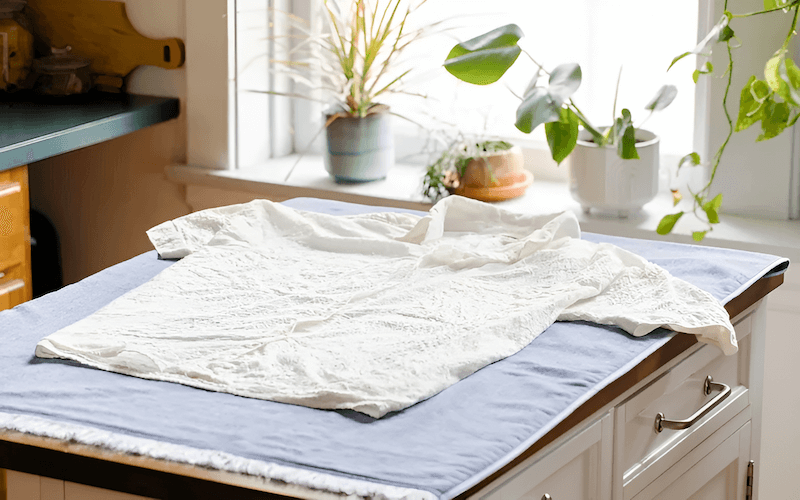
Space-Saving Solutions: Retractable Lines and Pulley Systems
For those with limited space, retractable clotheslines and pulley clothes airers offer convenient solutions. These systems can be tucked away when not in use.
4. Machine drying: The convenient option
Machine drying, using a tumble dryer, offers convenience and speed, especially for busy households. It’s a time-saving alternative to air drying, particularly in situations where outdoor drying isn’t feasible or when quick turnaround is needed.
4.1 Benefits of machine drying
The primary benefits of machine drying are speed and convenience.
4.2 Choosing the right dryer settings
Modern dryers offer a variety of settings to accommodate different fabric types and drying needs. Understanding these cycles, temperature options, and features like timed drying versus sensor drying is crucial for optimal results.
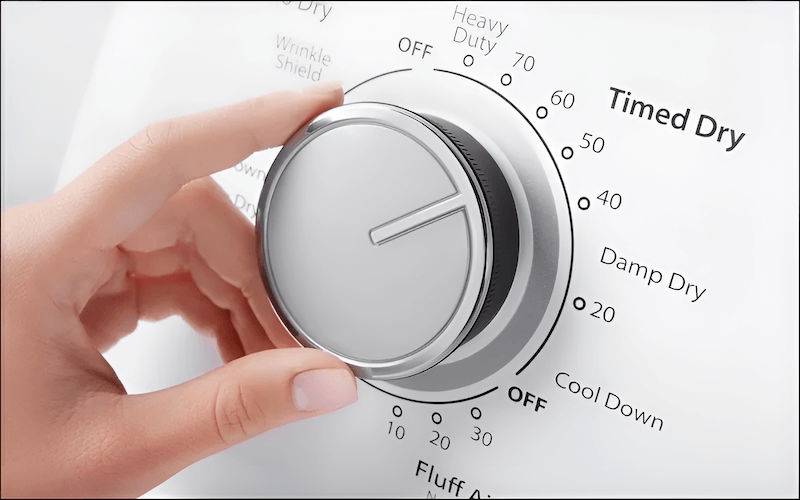
Understanding Dryer Cycles (Permanent Press, Delicate, etc.)
Dryer cycles are designed for specific fabric types and levels of dampness. The “Permanent Press” cycle, for instance, uses medium heat and a cool-down period to minimize wrinkles in synthetic fabrics.
Temperature Settings: Low, Medium, High
Temperature settings control the level of heat used during the drying process. Using high heat result in fast drying but may cause damage to delicate items.
Timed Drying vs. Sensor Drying
Timed drying allows you to set a specific drying duration, while sensor drying automatically detects the moisture level in the clothes and stops the cycle when they are dry.
4.3 Preparing clothes for the dryer
Proper preparation before machine drying is essential for achieving the best results and preventing damage.
Sorting by Fabric Type and Weight
Sorting clothes by fabric type and weight is crucial for machine drying. This ensures that items with similar drying needs are dried together, preventing over-drying or under-drying.
Emptying Pockets and Zipping Zippers
Emptying pockets and zipping zippers prevents damage to both the clothes and the dryer. Loose items in pockets can get caught or cause damage during the tumbling process.
Turning Clothes Inside Out (to prevent fading)
Turning clothes inside out, especially dark-colored items, helps to prevent fading.
4.4 Dryer tips and tricks
Various techniques can help you optimize your machine.
Avoiding Overloading the Dryer
Overloading the dryer restricts airflow, leading to longer drying times, increased wrinkles, and uneven drying.

Using Dryer Sheets or Dryer Balls (optional)
Dryer sheets and dryer balls serve different purposes. Dryer sheets are primarily used to add fragrance and reduce static cling, thanks to fabric softener. Dryer balls, on the other hand, help to separate clothes, improving airflow and reducing drying time.
Cleaning the Lint Filter (for efficiency and safety)
Cleaning the lint filter after every load is essential for both efficiency and safety. A clogged lint filter restricts airflow, making the dryer work harder and increasing energy consumption. It also poses a significant fire hazard.
Adding a Dry Towel
Adding a dry towel to a load of wet clothes can help absorb moisture.
Removing Clothes Promptly to Minimize Wrinkles
Removing clothes promptly from the dryer as soon as the cycle ends is crucial for minimizing wrinkles.
5. Special drying situations
Certain items and situations require specific drying approaches that go beyond the standard methods.
5.1 Drying large items: Bedding, towels, and blankets
Large items like bedding, towels, and blankets require special attention due to their size and bulk. They can easily bunch up in the dryer, leading to uneven drying.
5.2 Drying shoes
Drying shoes, especially running shoes, requires a careful approach to prevent damage and maintain their shape. It’s generally recommended to air dry shoes. Stuffing them with paper towels helps absorb moisture and maintain their shape. Avoid direct heat or sunlight.
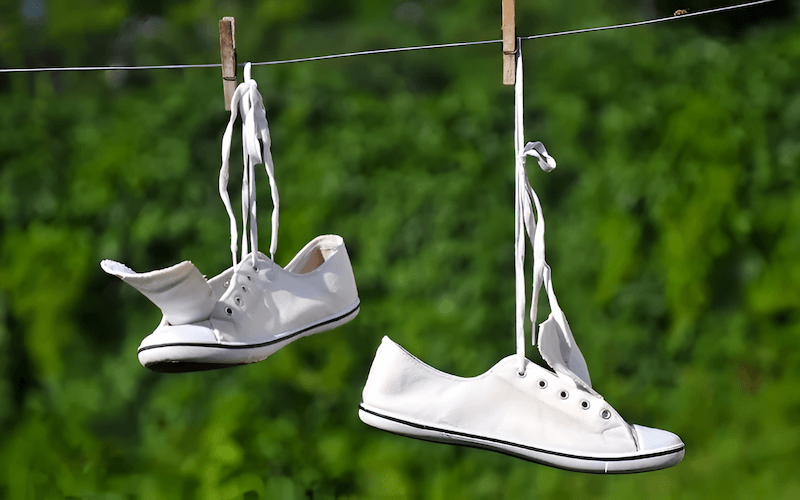
5.3 Handling clothes that have shrunk
If clothes have shrunk, there are some potential remedies, although success isn’t guaranteed. Gently stretching the garment while it’s damp can sometimes help to regain some of its original size.
5.4 Dealing with static cling
Static cling is a common issue, especially with synthetic fabrics. Dryer sheets and fabric softener are common solutions.
6. Related questions
6.1 How can I dry clothes quickly without a dryer?
To dry clothes fast without a dryer, start by wringing out as much water as possible. Then, roll the garment in a thick, absorbent towel to remove excess moisture. Finally, hang the item in a well-ventilated area, ideally near a fan or open window, to speed up the drying process.
6.2 What is the best way to dry white clothes?
The best way to dry white clothes is to hang them outside in direct sunlight. The sun’s UV rays act as a natural bleach, helping to keep your whites bright and fresh. If outdoor drying isn’t possible, use a dryer on a low setting or air dry indoors.
6.3 How do I prevent my clothes from smelling musty when air drying?
To prevent musty odors, ensure good air circulation. Hang clothes with space between them, and use a fan or dehumidifier if drying indoors. Also, make sure clothes are completely dry before storing them. Washing with a bit of white vinegar can also help eliminate odors.
6.4 Can I air dry clothes in the winter?
Yes, air drying clothes in winter is possible. Indoors, use a drying rack near a heat source (but not directly on it), and ensure good ventilation to prevent moisture buildup. Outdoors, clothes can still dry on cold, sunny days, although it will take longer.
6.5 Is it better to dry my clothes on a low or high setting?
The low heat setting is better. This method will take more time and be gentler on clothes, while the high heat setting will dry faster but risk damaging or shrinking clothes.
Read more:
Properly drying clothes is an essential part of garment care. Whether you choose the gentle approach of air drying or the convenience of machine drying, understanding the specific needs of different fabrics and employing the right techniques will help preserve clothes, save energy, and minimize environmental impact.
Visit our website https://mypacklove.com/ to explore our product options and request a quote. Contact us today to discuss your specific needs! Let us help you enhance your clothing care and branding efforts.






















